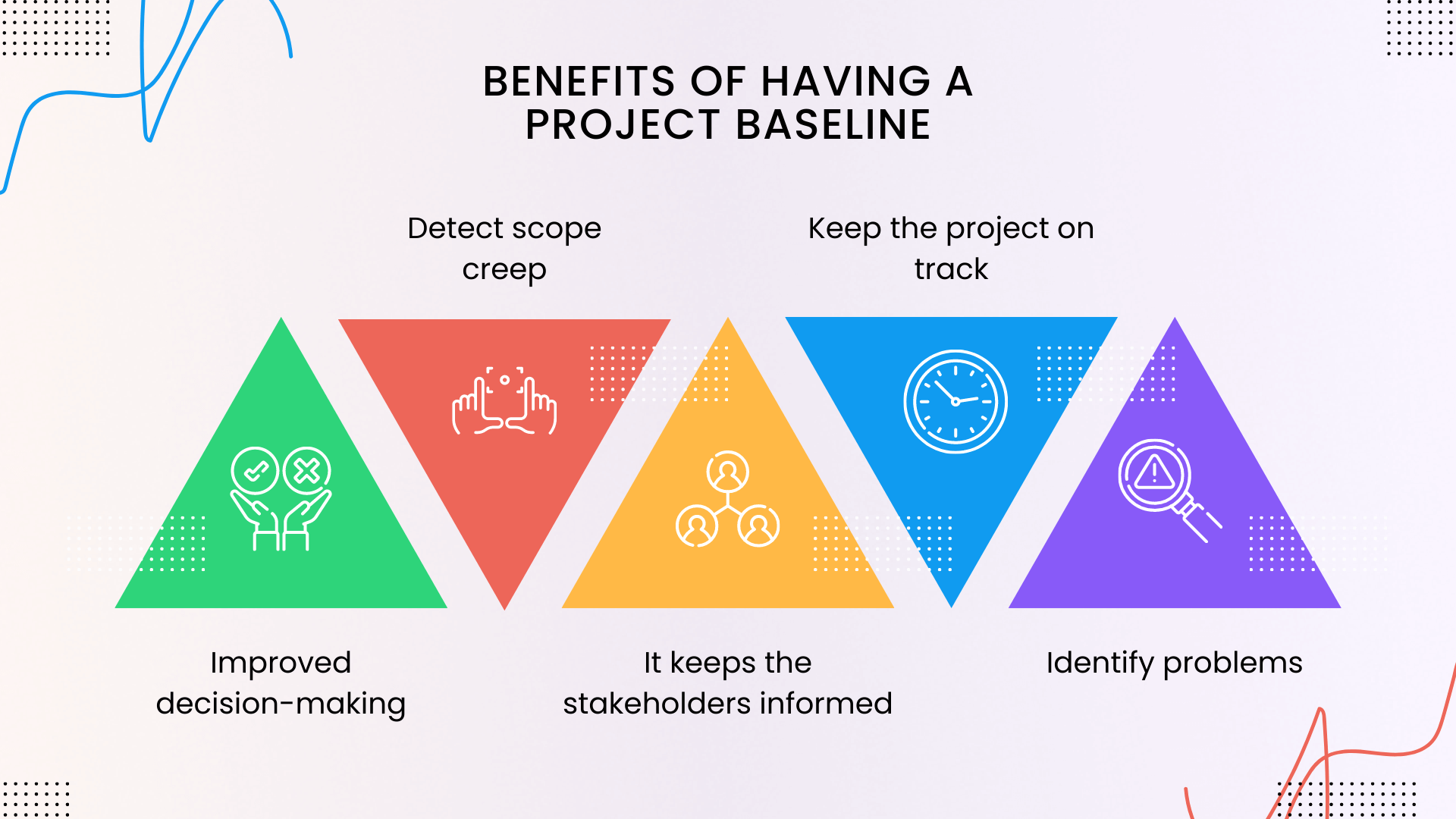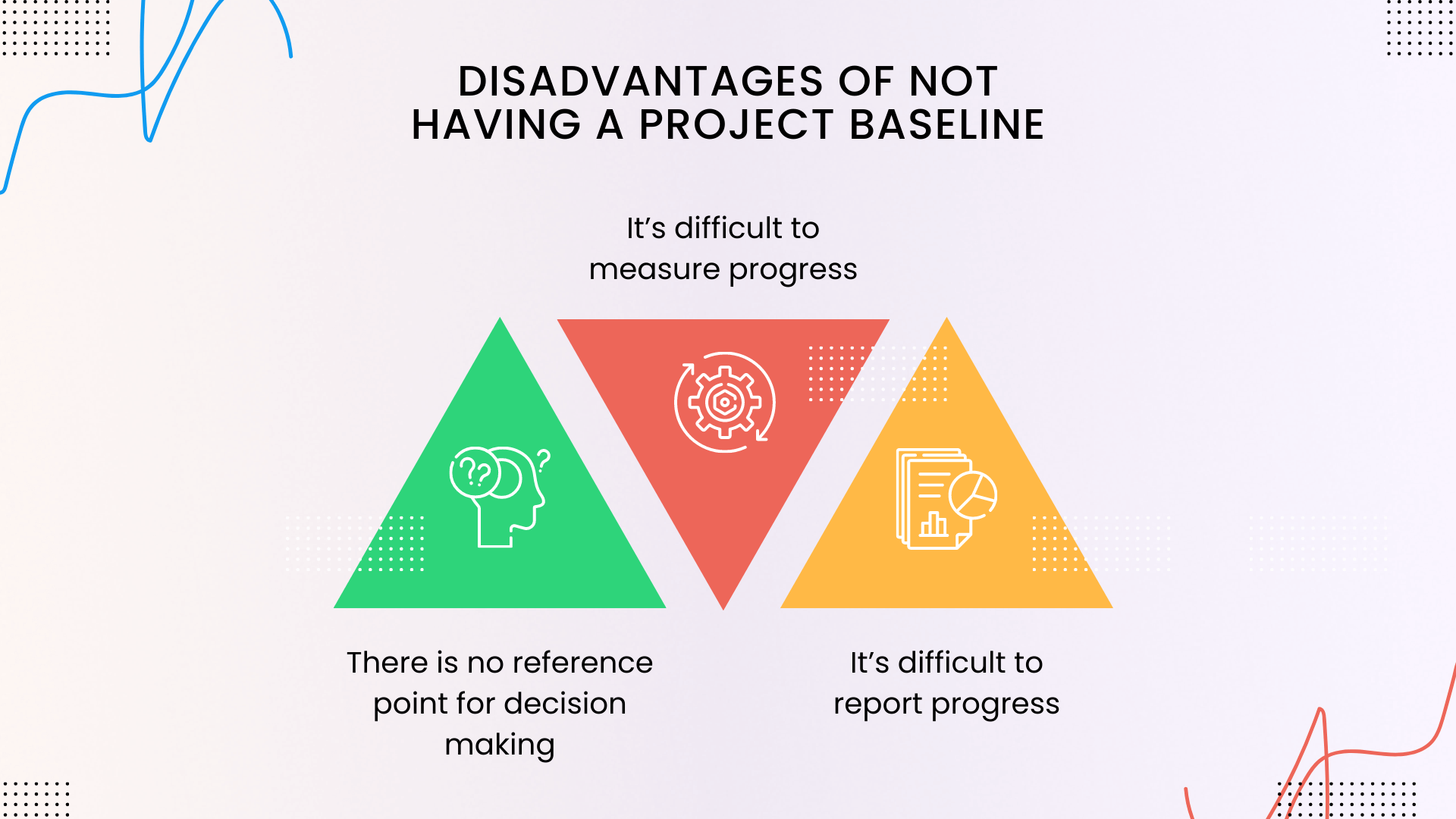When you start a project, you probably have some expectations about how it will go. Otherwise you would have no idea whether it is even worth pursuing.
Project baselines are simply documents formalizing your expectations so you can hold yourself and your team accountable.
In this article I’ll teach you the basics of project baselining including what it is, how to set up a project baseline, and how doing this effectively can improve your business.
What is a Project Baseline?
A project baseline is a document that memorializes a set of expectations against which a project’s success is measured. It is the expected scope, schedule, and budget, usually in a form that has been approved by stakeholders.
Project managers create project baselines in order to track whether a project is meeting, exceeding, or falling short of expectations.
Why a Project Baseline is Important
Baselines in project management are like measuring tape: without them, everything is just guesswork. Is the project behind or ahead of schedule? Is it above or below budget? These questions only make sense when you can measure the actual against a baseline projection.
In addition to giving you a reference point for measuring the success of a project, the act of baselining a project forces you to think clearly about the time and resources needed for a project, as well as objectives and constraints. Managing baselines is not separate from planning, scheduling, and budgeting; it is all part of the same process.
The time spent preparing and adhering to a project baseline can be the difference between success and failure. Done right, a project can run smoothly and meet all its goals. Done wrong, and a project can easily spin out of control. That is why a project baseline is such an important part of effective project management.
Types of Project Baseline
A project baseline is divided into three components for scope, schedule, and cost.
Scope Baseline
Your scope baseline is a document that specifies the deliverables that are within the scope of the project.
For example, if your project is to build a car, deliverables would include things like headlights and wheels. It would probably not include a jet engine (unless it’s a really really fast car).
Any deliverables not in the scope baseline are considered out of scope. In order to keep a project focused and on track, project managers resist the tendency for projects to creep beyond their scope and add new deliverables.
Schedule Baseline
A schedule baseline is a document that contains the key dates, deadlines, and durations that make up your project timeline. A project manager will prepare a schedule baseline with input from all the stakeholders involved, taking care to include a buffer for contingencies and delays.
Throughout the project the projected dates may be updated with actual dates, and the schedule may change accordingly, but all versions of the schedule baseline should be preserved in order to measure how successfully the project adhered to the original baseline.
Cost Baseline
A cost baseline is a document containing the planned expenditures that make up the projected budget, as well as when the money will be spent.
As with a schedule baseline, the cost baseline will keep track of expected versus actual. All of these baselines can be subject to change, but typically that requires approval from stakeholders.
Benefits of Having a Project Baseline
These are some of the benefits of preparing a formal project baseline for your project.

1. Detect scope creep
Scope creep occurs when new features or deliverables are added that aren’t within the planned scope of the project.
During the course of a project, it is not uncommon for new ideas and suggestions to arise. These may be great ideas from the development team or management that are nevertheless not part of the project’s scope. But however well-intentioned the suggestions may be, scope creep can cause a project to veer off course by adding deliverables without consideration for the budget or timeline. Having a project baseline in place can help identify scope creep and protect the core deliverables from getting sidelined.
2. Keep the project on track
By monitoring and measuring the project against the baseline, project managers can ensure that the project is staying on track and that the objectives are being achieved.
3. Improved decision-making
The baseline provides a framework for decision making by providing visibility into the scope, timeline, and cost of the project. Decisions that require changing the baseline may require extra scrutiny and approval.
4. It keeps the stakeholders informed
As a document, the project baseline serves as an important source of truth for all the stakeholders, as well as a way to measure progress.
5. Identify problems
The project baseline can be a way to detect potential problems so you can address them proactively. For example, a gantt chart in the schedule baseline might reveal a change that will cause the project to miss its deadline. Or an adjusted line item in the cost baseline could put the project over budget.
Disadvantages of Not Having a Project Baseline
We’ve covered the advantages of having a project baseline, but what about the disadvantages of not having a baseline? Let’s explore those next.

1. It’s difficult to measure progress
Without a baseline in place, how do you track progress and performance against the original plan? By definition, progress has to be measured against something.
2. There is no reference point for decision making
Without a baseline, project teams are less able to make informed decisions, since they don’t have a clear understanding of the project’s objectives and timeline.
3. It’s difficult to report progress
A formal project baseline provides you with the documentation that you need to report progress and performance to stakeholders. When you haven’t prepared a project baseline at the beginning, you may end up having to recreate the baseline in the reporting documents you prepare for the stakeholders.
Example of a Project Baseline
Suppose you work for a brick and mortar pet food store and you have been tasked with setting up an online store. The skeleton of your project baseline might look something like this:
Scope: an ecommerce website with a product catalog, shopping cart, checkout flow, and payment processor.
Schedule: two months.
Cost: $3000
Of course, the actual project baseline document you prepare would be much more detailed, include all conceivable deliverables, a line-itemed budget, etc. But the above is an example of the basics that constitute the project baseline: a scope, a schedule, and a budget.
How to Setup a Project Baseline
Now that you have an idea what a project baseline is and what it is for, you may be wondering where to start in creating your own project baseline. Just follow the steps below and you’ll be project baselining like a pro.
Define the project deliverables
Your first step is to define the scope of the project by outlining the deliverables. It is often helpful to start broad and then get specific.
For example you might start with “a website” as a deliverable, then expand that to “a responsive ecommerce website with customer checkout, a product catalog…” etc.
Estimate the costs
Once you know the scope of the project, you can start investigating the costs to come up with a realistic cost estimate. You will likely need to consult with the development team and the finance department to get a handle on the requirements in terms of labor, materials, and overhead.
Note that the cost estimate is not exactly the same as the budget, because in the budget you will likely add a buffer for overruns and contingencies.
Estimate the timeline
Your time estimate will be heavily dependent on input from the development team. But you should consult with all the stakeholders to be aware of any key deadlines, targets, or potential scheduling conflicts.
As you gather the time estimates, organize the process into a sequence and begin to set start and end dates accordingly.
Identify the risks
Identify the potential risks that may arise during the life of the project and use them to determine what kinds of buffers should be put into the schedule and budget baselines. Every estimate relies on certain assumptions, so your goal is to identify the risks to those assumptions.
Document the baseline
Prepare the actual project baseline document that you will provide to all stakeholders so they understand the project’s expectations. This could be done in a spreadsheet, a word document, or a slide deck.
Monitor the baseline
Your work is not done when you complete the project baseline. Now you must monitor the baseline throughout the project’s lifecycle to ensure that the project is staying on track.
When Should a Project Baseline Be Changed?
The goal is to follow the project baseline, not change it, but sometimes adjustments may be necessary. In that case there is typically a formal change process, such as submitting a change form that requires input from stakeholders and approval from management. Then you will create a new project baseline, not update the original, so that a record is preserved.
Here are some of the scenarios where you might need to re-baseline the project:
The scope of the project changes
The purpose of the scope baseline is to resist scope creep. Yet if management insists on modifying the scope, you may have to comply. In that case the formal change process ensures that everyone is aware that the scope has officially been changed, lest any stakeholders take such change lightly.
The costs of the project changes
Changes to third party prices or other market forces are outside of your control. You should try to account for these things in your budget, but ultimately you may have no choice but to re-baseline the budget if a significant change occurs.
The timeline of the project changes
A missed start date is a missed start date. Your schedule baseline will have projected and actual dates, but if a significant delay occurs you may be forced to re-baseline the schedule based on the new timeline.
The risks of the project change
I mentioned that you may need to update the cost or schedule baselines based on an actual change to the cost or timeline, but what about a change to a risk?
You have likely put a buffer into your schedule and budget to reflect risks or uncertainties. If those risks change, it may make sense to modify the schedule or budget accordingly. In that case, you may wish to re-baseline the project to have the most accurate baseline going forward.
Conclusion
Hopefully you now have a clear understanding of what a project baseline is, why it is useful, and how you can make one for your project.
Even if you have not prepared a formal project baseline, it is likely that you have been through parts of the process before in the planning phase of any project. After all, the project baseline is really just a formal document to memorialize the planned cost, timeline, and scope of a project.
When it comes to sharing a project baseline with stakeholders, Ahsuite is an especially good tool because of the flexible way it handles file sharing, versioning, and approvals. Ahsuite also has the task management functionality to handle most projects of any size.
If you’re ready to see if Ahsuite client portals are a good fit for your project baselining needs, you can start a free trial today without even entering a credit card.

